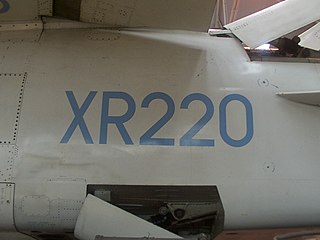 W
WAircraft camouflage is the use of camouflage on military aircraft to make them more difficult to see, whether on the ground or in the air. Given the possible backgrounds and lighting conditions, no single scheme works in every situation. A common approach has been a form of countershading, the aircraft being painted in a disruptive pattern of ground colours such as green and brown above, sky colours below. For faster and higher-flying aircraft, sky colours have sometimes been used all over, while helicopters and fixed-wing aircraft used close to the ground are often painted entirely in ground camouflage. Aircraft flying by night have often been painted black, but this actually made them appear darker than the night sky, leading to paler night camouflage schemes. There are trade-offs between camouflage and aircraft recognition markings, and between camouflage and weight. Accordingly, visible light camouflage has been dispensed with when air superiority was not threatened or when no significant aerial opposition was anticipated.
 W
WAn aircraft livery is a set of comprehensive insignia comprising color, graphic, and typographical identifiers which operators apply to their aircraft.
 W
WAn aircraft registration, alternatively called a tail number, is a code unique to a single aircraft, required by international convention to be marked on the exterior of every civil aircraft. The registration indicates the aircraft's country of registration, and functions much like an automobile license plate or a ship registration. This code must also appear in its Certificate of Registration, issued by the relevant National Aviation Authority (NAA). An aircraft can only have one registration, in one jurisdiction, though it is changeable over the life of the aircraft.
 W
WBelgian owned and operated aircraft are identified by either registration letters or serial numbers for military aircraft.
 W
WIn 1997 British Airways (BA) adopted a new livery. One part of this was a newly stylised version of the British Airways "Speedbird" logo, the "Speedmarque", but the major change was the introduction of tail-fin art. Also known as the Utopia or world image tailfins, they used art and designs from international artists and other sources to represent countries on BA's route network. The signature of the artist was carried near the design on the tail.
 W
WA buzz number was a large letter and number combination applied to United States Air Force military aircraft in the years immediately after World War II, through the early 1960s. They were applied for general aerial identification of aircraft, but particularly for the identification of aircraft guilty of "buzzing" over populated areas.
 W
WInvasion stripes were alternating black and white bands painted on the fuselages and wings of Allied aircraft during World War II to reduce the chance that they would be attacked by friendly forces during and after the Normandy Landings. Three white and two black bands were wrapped around the rear of a fuselage just in front of the empennage (tail) and from front to back around the upper and lower wing surfaces.
 W
WA logojet is an airliner with an advertising paint scheme. Logojets used for advertising companies remain uncommon due to the time and cost of repainting an entire airliner.
 W
WLozenge camouflage was a military camouflage scheme in the form of patterned cloth or painted designs used by some aircraft of the Central Powers in the last two years of World War I, primarily those of the Imperial German Luftstreitkräfte. It takes its name from the repeated polygon shapes incorporated in the designs, many of which resembled lozenges. In Germany it was called Buntfarbenaufdruck but this designation includes other camouflage designs such as Splittermuster and Leibermuster, and does not include hand-painted camouflage.
 W
WMilitary aircraft insignia are insignia applied to military aircraft to identify the nation or branch of military service to which the aircraft belongs. Many insignia are in the form of a circular roundel or modified roundel; other shapes such as stars, crosses, squares, or triangles are also used.
 W
WNIVO, abbreviated from Night Invisible Varnish Orfordness, was a dark grey-green overall finish applied to British night bomber aircraft in the inter-war period (1918-1939).
 W
WNose art is a decorative painting or design on the fuselage of an aircraft, usually on the front fuselage.
 W
WThe Air Force checkerboard is a national marking for the aircraft of the Polish Air Force, equivalent to roundels used in other nations' air forces. It consists of four equal squares, of which the upper left and lower right are white, and the other two – red. These are surrounded by a border of inverted (counterchanged) colors 1/5 the thickness of a single square. In 1993 the colors were reversed.
 W
WIn Portugal to identify individual aircraft, all military aircraft are allocated and display a serial number. A common serial number system is used for aircraft operated by the three military branches, the Portuguese Air Force, Portuguese Naval Aviation and Portuguese Army. Individual agencies have each their own system.
 W
WThe air forces of the United Kingdom – the Royal Navy's Fleet Air Arm, the Army's Army Air Corps and the Royal Air Force use a roundel, a circular identification mark, painted on aircraft to identify them to other aircraft and ground forces. In one form or another, it has been used on British military aircraft from 1915 to the present.
 W
WThe Speedbird is the stylised emblem of a bird in flight designed in 1932 by Theyre Lee-Elliott as the corporate logo for Imperial Airways. It became a design classic and was used by the airline and its successors – British Overseas Airways Corporation and British Airways – for 52 years. The term "Speedbird" is still the call sign for British Airways.
 W
WMost units of the Royal Air Force are identified by a two character alphabetical or alpha- numeric combination squadron code. Usually, that code is painted on the aircraft belonging to that unit. The squadron code is usually presented along with an individual letter or character to form a call sign for the particular aircraft. Location of the call sign combination has usually been on the rear fuselage next to the RAF roundel.
 W
WTail codes are markings usually on the vertical stabilizer of U.S. military aircraft that help identify the aircraft's unit and/or base assignment. This is not the same as the serial number, bureau number, or aircraft registration which provide unique aircraft identification.
 W
WTail codes on the U.S. Navy aircraft are the markings that help to identify the aircraft's unit and/or base assignment. These codes comprise one or two letters or digits painted on both sides of the vertical stabilizer, on the top right and on the bottom left wings near the tip. Although located both on the vertical stabilizer and the wings from their inception in July 1945, these identification markings are commonly referred as tail codes. It is important to note that tail codes are meant to identify units and assignments, not individual aircraft. For all aircraft of the U.S. Navy and U.S. Marine Corps unique identification is provided by bureau numbers.
 W
WUnited Kingdom aircraft registration is a register and means of identification for British owned and operated commercial and private aircraft, they are identified by registration letters starting with the prefix G-.
 W
WUnited Kingdom military aircraft serial numbers are aircraft registration numbers used to identify individual military aircraft in the United Kingdom (UK). All UK military aircraft are allocated and display a unique registration number. A unified registration number system, maintained initially by the Air Ministry (AM), and its successor the Ministry of Defence (MoD), is used for aircraft operated by the Royal Air Force (RAF), Fleet Air Arm (FAA), and Army Air Corps (AAC). Military aircraft operated by government agencies and civilian contractors are also assigned registration numbers from this system.
 W
WThis is a listing of the nationality markings used by military aircraft of the United States, including those of the U.S. Air Force, U.S. Navy, U.S. Marine Corps, U.S. Coast Guard, U.S. Army and their predecessors. The Civil Air Patrol is also included for the World War II period because it engaged in combat operations which its July 1946 charter has since explicitly forbidden.
 W
WIn the United States, all military aircraft display a serial number to identify individual aircraft. These numbers are located on the aircraft tail, so they are sometimes referred to unofficially as "tail numbers". On the Northrop Grumman B-2 Spirit bomber, lacking a tail, the number appears on the nose gear door. Individual agencies have each evolved their own system of serial number identification. Aircraft serials are part of the Aircraft Visual Identification System, which also includes the aircraft's tail code and Modex.
 W
WUSAAF unit identification aircraft markings, commonly called "tail markings" after their most frequent location, were numbers, letters, geometric symbols, and colors painted onto the tails, wings, or fuselages of the aircraft of the United States Army Air Forces (USAAF) during the Second World War. The purpose of these markings was as call signs in the RAF radio procedures used in the UK and to provide a visual means identify in conjunction with the call procedures, and later assembly and combat visual identification of units and aircraft. to denote a squadron and a third single letter was known as the Radio Call Letter (RCL) to identify the aircraft within the squadron, used phonetically in radio calls. Other areas continued to use only the RCN or simple numbering and lettering.